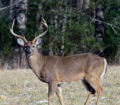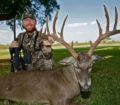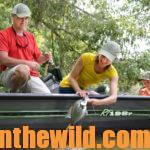John’s Note: When I called to interview Cody Robbins, he said, “Can I call you back, John, in about 2 hours? We’ve just seen a giant mule deer buck, and my friend is about to take him. I’m shooting the video and the pictures.” Robbins is the owner and producer of the TV show, “Live 2 Hunt (www.live2hunt.com) with Cody and Kelsy Robbins.” Many deer hunters have said, “If I had the money and the time I’d have my own TV show.” Others have told friends, “I bet those guys who have the hunting TV shows can’t find and take a buck on public lands.” Yet another group may think, “If those hosts of TV deer-hunting shows would let me hunt where they get to hunt, I could take a lot of deer, too!” This week we’ll learn how true those statements are by talking with Cody Robbins of central Saskatchewan, Canada. So, what’s required to get your own TV show, how do you learn that business, and what’s the best way to get into it? I’ve known, hunted with and interviewed many of the outdoor hunting TV hosts and learned that they’re hard-working people who are engaged in hunting all year long. The story of Cody Robbins, how he’s learned his craft, and how he’s put a TV show on the “Outdoor Channel” is well worth the telling.
When I started hunting, I’d buy over-the-counter deer tags for Saskatchewan, which is the province where I live in Canada. I hunted all public land but took some really-nice bucks and learned to hunt deer. However, in the last 2 years, my wife Kelsy and I have had outfitters offer to let us come hunt on their lands to get some exposure for their hunting operations and showcase the type of animals on their lands. We’re very, very lucky to have chances like this. When I was hunting public lands I’d spend hours out in the fields setting-up trail cameras and looking for big bucks. And, on any given day, I’d have as many as 30-different Stealth (http://www.stealthcam.com/) cameras taking pictures of deer. In the summertime, I’d sit on the tops of high hills with my spotting scope, trying to locate big mule deer bucks. I’d learned that the people who put in the most hours scouting and using trail cameras, maps and spotting scopes consistently took bigger bucks. That had worked for Kelsy and me.
 I try to find really-big bucks during the summer months, and once I locate an older-age-class buck, whether he’s a mule deer or a whitetail, I want to spend as much time as I can learning where he lives, what he eats, and where he moves. I’m a husband, a father and a cattle rancher, but every morning before and just at daylight, I spend my time finding and observing big deer. I also spend every afternoon after my chores are done, finding and observing big deer. I want to know where that buck goes on a windy day, where he beds down if our area has a north wind, and where he beds down, if we have a south wind. If that buck disappears for 2-3 days, I want to go find him, so I’ll know where he’s at when he’s not supposed to be there. If that buck has two or three different bedding areas, I need to identify where they are. Since bucks have individual personalities, if I’m going to take that buck during hunting season, I want to learn all I can about that buck before hunting season arrives. Once hunting season comes in, mature bucks generally become nocturnal and only move at night.
I try to find really-big bucks during the summer months, and once I locate an older-age-class buck, whether he’s a mule deer or a whitetail, I want to spend as much time as I can learning where he lives, what he eats, and where he moves. I’m a husband, a father and a cattle rancher, but every morning before and just at daylight, I spend my time finding and observing big deer. I also spend every afternoon after my chores are done, finding and observing big deer. I want to know where that buck goes on a windy day, where he beds down if our area has a north wind, and where he beds down, if we have a south wind. If that buck disappears for 2-3 days, I want to go find him, so I’ll know where he’s at when he’s not supposed to be there. If that buck has two or three different bedding areas, I need to identify where they are. Since bucks have individual personalities, if I’m going to take that buck during hunting season, I want to learn all I can about that buck before hunting season arrives. Once hunting season comes in, mature bucks generally become nocturnal and only move at night.
I scout so much in the summer, because I realize I only may see that buck one time during the last 5 minutes of legal shooting time, or during the first 5 minutes of daylight. So, if I don’t learn all I can about that bruiser buck during the summer and know where he likes to live, then the odds of my taking that buck are really small. If I’m not in the right place to take that buck during deer season when he does move in daylight hours, then I’ve wasted a summer. Finding a big buck and trying to pattern him during deer season is much-more difficult than locating a big buck during the summer and learning where he likes to live. The summer months when very few people are trying to identify bucks are the most-critical time for us to identify the bucks we want to take when deer season opens.
 Each year Kelsy and I hunt and film 75% of the time on public lands. Twenty-five percent of our hunts will be on private lands where we’ve asked a rancher if we can hunt his property and get permission to hunt there. On the lands we hunt for our TV show, we don’t have exclusive rights to hunt those lands. For the most part, other people can hunt where we hunt. Even when we get permission to hunt private lands, often three to a dozen people may have permission to hunt that same land. About 60% of the deer hunts we film for our TV shows are in Canada where we live. About 40% of the shows are done across the border in the northwestern portion of the United States. We also hunt some in Alaska, the Yukon and British Columbia. We wear Mossy Oak (http://www.mossyoak.com/mountain-country.aspx) Mountain Country, because it blends in where I primarily hunt in the Northwest U.S. and Canada.
Each year Kelsy and I hunt and film 75% of the time on public lands. Twenty-five percent of our hunts will be on private lands where we’ve asked a rancher if we can hunt his property and get permission to hunt there. On the lands we hunt for our TV show, we don’t have exclusive rights to hunt those lands. For the most part, other people can hunt where we hunt. Even when we get permission to hunt private lands, often three to a dozen people may have permission to hunt that same land. About 60% of the deer hunts we film for our TV shows are in Canada where we live. About 40% of the shows are done across the border in the northwestern portion of the United States. We also hunt some in Alaska, the Yukon and British Columbia. We wear Mossy Oak (http://www.mossyoak.com/mountain-country.aspx) Mountain Country, because it blends in where I primarily hunt in the Northwest U.S. and Canada.
Be cause we’re on the “Outdoor Channel,” we want to reach across the border between the U.S. and Canada. Then our American audience can relate to the type of deer hunting we do on the properties they hunt. We want to hunt the country and the animals they hunt. About 40% of the shows we do each year are mule deer hunts; and most of the rest of the shows are whitetail hunts. Almost all of our whitetail hunting is on public lands. I’ve spent the last 15 years driving the roads on public lands in Canada and the U.S. to find the productive places to successfully hunt big whitetails. I hunt a lot of what’s called community pastures, that aren’t open for hunting until after the grazing season for cattle. We’ve been far more successful hunting mule deer than we have whitetails. I struggled 10 years ago when I first started hunting whitetails, until I developed a system for taking older-age-class whitetails on public lands.
cause we’re on the “Outdoor Channel,” we want to reach across the border between the U.S. and Canada. Then our American audience can relate to the type of deer hunting we do on the properties they hunt. We want to hunt the country and the animals they hunt. About 40% of the shows we do each year are mule deer hunts; and most of the rest of the shows are whitetail hunts. Almost all of our whitetail hunting is on public lands. I’ve spent the last 15 years driving the roads on public lands in Canada and the U.S. to find the productive places to successfully hunt big whitetails. I hunt a lot of what’s called community pastures, that aren’t open for hunting until after the grazing season for cattle. We’ve been far more successful hunting mule deer than we have whitetails. I struggled 10 years ago when I first started hunting whitetails, until I developed a system for taking older-age-class whitetails on public lands.
To get John E. Phillips’ eBooks and print books on hunting deer, including his newest deer-hunting book, “Whitetail Deer and the Hunters Who Take Big Bucks,” available at http://amzn.to/2bYwYOK/, click on these books to learn more, “How to Hunt and Take Big Buck Deer on Small Properties,” “How to Hunt Deer Up Close: With Bows, Rifles, Muzzleloaders and Crossbows,” “PhD Whitetails: How to Hunt and Take the Smartest Deer on Any Property,” “How to Take Monster Bucks,” “How to Hunt Deer Like a Pro,” and “Bowhunting Deer: Mossy Oak Pros Know Bucks and Bows,” or to prepare venison, “Deer & Fixings.” Or, go to www.amazon.com/kindle-ebooks, type in the name of the book, and download it to your Kindle, and/or download a Kindle app for your iPad, SmartPhone or computer. You also can find John’s books on Nook at www.barnesandnoble.com.
For information on making jerky from your deer to provide a protein-rich snack, you can download a free book, “How to Prepare Venison Jerky: The Ultimate Snack Food,” from https://johninthewild.com/fee-books.










